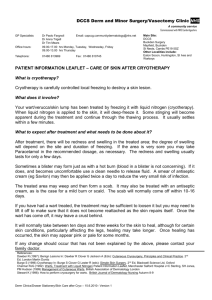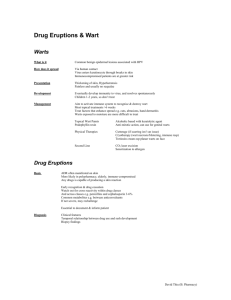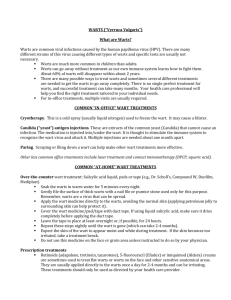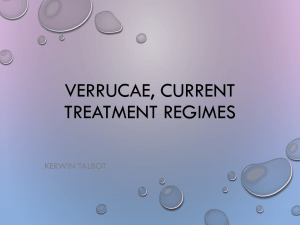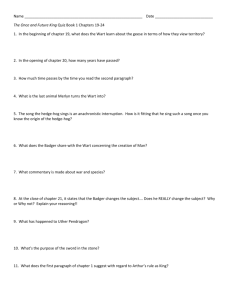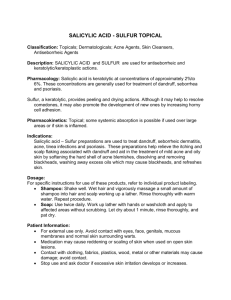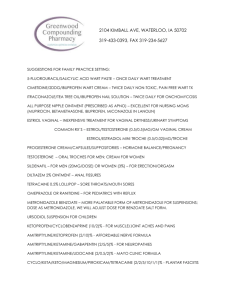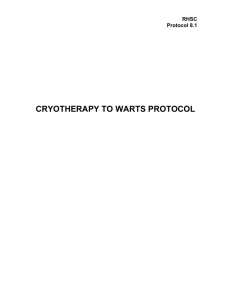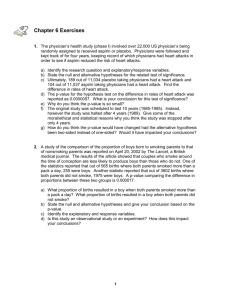Warts and verrucas advice sheet
advertisement
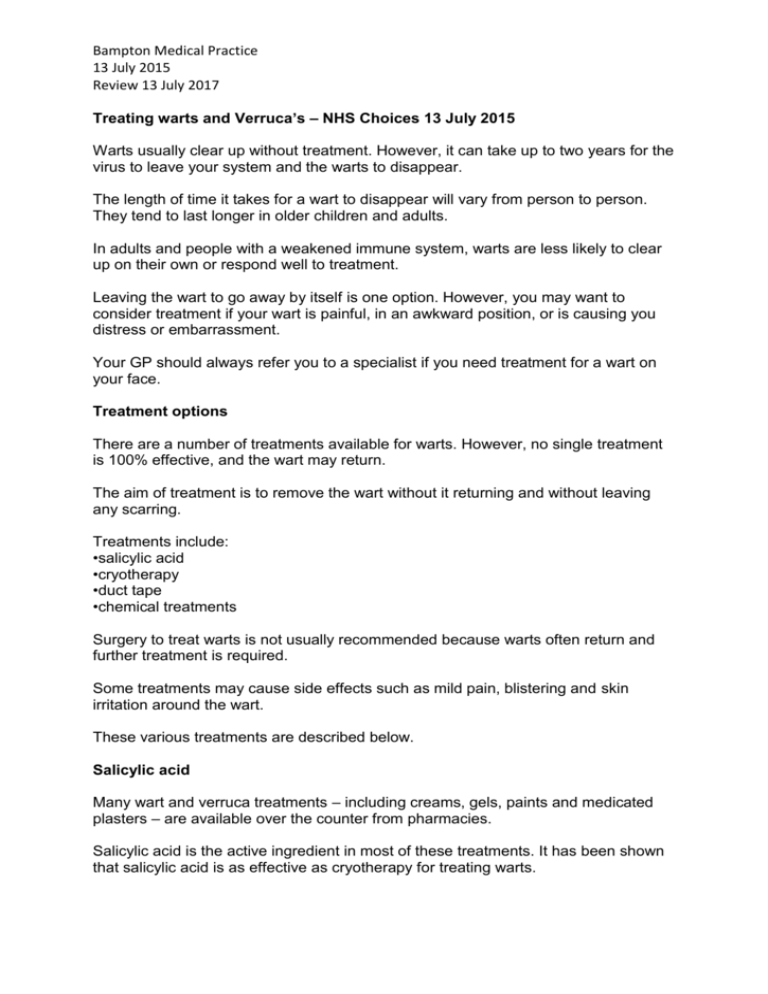
Bampton Medical Practice 13 July 2015 Review 13 July 2017 Treating warts and Verruca’s – NHS Choices 13 July 2015 Warts usually clear up without treatment. However, it can take up to two years for the virus to leave your system and the warts to disappear. The length of time it takes for a wart to disappear will vary from person to person. They tend to last longer in older children and adults. In adults and people with a weakened immune system, warts are less likely to clear up on their own or respond well to treatment. Leaving the wart to go away by itself is one option. However, you may want to consider treatment if your wart is painful, in an awkward position, or is causing you distress or embarrassment. Your GP should always refer you to a specialist if you need treatment for a wart on your face. Treatment options There are a number of treatments available for warts. However, no single treatment is 100% effective, and the wart may return. The aim of treatment is to remove the wart without it returning and without leaving any scarring. Treatments include: •salicylic acid •cryotherapy •duct tape •chemical treatments Surgery to treat warts is not usually recommended because warts often return and further treatment is required. Some treatments may cause side effects such as mild pain, blistering and skin irritation around the wart. These various treatments are described below. Salicylic acid Many wart and verruca treatments – including creams, gels, paints and medicated plasters – are available over the counter from pharmacies. Salicylic acid is the active ingredient in most of these treatments. It has been shown that salicylic acid is as effective as cryotherapy for treating warts. Bampton Medical Practice 13 July 2015 Review 13 July 2017 There is limited evidence available to show which type of salicylic acid treatment (cream, gel, paint or plasters) is most effective. Salicylic acid and other wart treatments also destroy healthy skin, so it is important to protect your skin before applying the treatment. You can use petroleum jelly or a corn plaster to cover the skin around the wart. Before applying the treatment to your wart, use an emery board or pumice stone to file it down a little (avoid sharing the board or pumice stone with others). Repeat this about once a week while you are treating your warts. Each time you treat your wart, soak it in water for about five minutes first to soften it, then follow the instructions that come with the medication. You may need to apply the treatment every day for 12 weeks or longer. You should stop the treatment if your skin becomes sore, and seek advice from your GP or pharmacist. Don't use treatments that contain salicylic acid to treat warts on your face. Ask your GP or pharmacist for advice about the best type of treatment. Consult your GP before using over-the-counter treatments that contain salicylic acid if you have poor circulation – for example, if you have a condition like diabetes or peripheral arterial disease (PAD). This is because there is an increased risk of damage to your skin, nerves and tendons. Cryotherapy In cryotherapy, liquid nitrogen is applied to your wart for a few seconds to freeze and destroy the affected skin cells. After treatment, a sore blister will form, followed by a scab, which will fall off 7-10 days later. A session of cryotherapy usually takes 5-15 minutes and can be painful. Large warts usually need to be frozen a few times before they clear up. You will probably need to wait a few weeks between each treatment. There are two different cryotherapy methods. Liquid nitrogen may be sprayed directly onto the wart, or it may be applied using a stick with cotton wool on the tip. This second method is often preferred for treatment around the eyes or for small children. Cryotherapy may be recommended if you have a wart on your face. This is because the risk of irritation is lower than when using salicylic acid or duct tape. Cryotherapy is not usually recommended to treat young children because they may find the treatment too painful. It may also be difficult for them to stay in the same position while having the treatment. If cryotherapy hasn't been successful within three months, further treatments aren't likely to be effective. Bampton Medical Practice 13 July 2015 Review 13 July 2017 Possible side effects of cryotherapy include: •pain and blistering •your skin may become darker (hyperpigmentation) or lighter (hypopigmentation) – particularly if you have black skin •your nails may develop an abnormal change in shape or structure if cryotherapy is used to treat warts that develop around the nails (periungual warts) Cryotherapy is sometimes carried out at GP surgeries or at hospital skincare clinics. However, it may not be available on the NHS in all areas of the country. A very cold spray (dimethyl ether propane) is also available from pharmacies, which you can apply yourself. You should avoid using this spray on your face. Evidence suggests these sprays are not as effective as cryotherapy using liquid nitrogen. Duct tape Treatment with duct tape involves placing a piece of duct tape over your wart for about six days. If the tape falls off, simply replace it with a fresh piece. After six days, remove the tape and soak the wart in water. After soaking the wart, use an emery board or pumice stone to get rid of any rough areas. Leave the wart uncovered overnight and apply a new piece of duct tape the following morning. This procedure should be repeated for a period of up to two months. There is limited evidence to support the effectiveness of using duct tape to treat warts. However, side effects of this type of treatment are rare, although the skin can become irritated. Chemical treatments Warts can also be treated using chemical treatments available on prescription. The treatments contain chemicals such as: •formaldehyde •glutaraldehyde •silver nitrate These chemicals are applied to the warts to kill affected skin cells. Potential side effects include the skin being stained brown (with glutaraldehyde) and burns to the surrounding skin (with silver nitrate). Bampton Medical Practice 13 July 2015 Review 13 July 2017 Treating warts during pregnancy If you are pregnant and have warts, your GP may recommend using salicylic acid, cryotherapy or duct tape. Salicylic acid can be used to treat warts during pregnancy, as long as it is used on a small area for a limited period of time. Swimming advice If you or your child has a wart or verruca, going swimming is fine as long as you take steps to prevent the spread of infection. You can put a waterproof plaster over the wart or verruca. Special rubber verruca socks are also available from pharmacies. Wearing pool slippers or flip-flops around swimming pools and in communal changing areas will also reduce the risk of getting verruca’s or passing them on to others.
